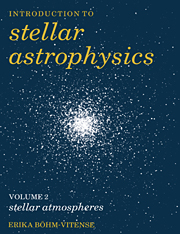Book contents
- Frontmatter
- Contents
- Preface
- 1 Stellar magnitudes and stellar colors
- 2 Stellar spectra
- 3 Temperature estimates for stars
- 4 Basics about radiative transfer
- 5 Radiative transfer in stellar atmospheres
- 6 The depth dependence of the source function
- 7 The continuous absorption coefficient
- 8 The influence of the non-greyness of the absorption coefficient
- 9 The pressure stratification
- 10 Theory of line formation
- 11 The hydrogen lines
- 12 Spectrum analysis
- 13 Basics about non-local thermodynamic equilibrium
- 14 The hydrogen convection zone
- 15 Stellar chromospheres, transition layers, and coronae
- 16 Stellar winds
- Problems
- Appendix LTE model stellar atmospheres
- References
- Index
14 - The hydrogen convection zone
Published online by Cambridge University Press: 08 February 2010
- Frontmatter
- Contents
- Preface
- 1 Stellar magnitudes and stellar colors
- 2 Stellar spectra
- 3 Temperature estimates for stars
- 4 Basics about radiative transfer
- 5 Radiative transfer in stellar atmospheres
- 6 The depth dependence of the source function
- 7 The continuous absorption coefficient
- 8 The influence of the non-greyness of the absorption coefficient
- 9 The pressure stratification
- 10 Theory of line formation
- 11 The hydrogen lines
- 12 Spectrum analysis
- 13 Basics about non-local thermodynamic equilibrium
- 14 The hydrogen convection zone
- 15 Stellar chromospheres, transition layers, and coronae
- 16 Stellar winds
- Problems
- Appendix LTE model stellar atmospheres
- References
- Index
Summary
Introduction
In Volume 1 we saw that the surface of the sun is not smooth, but that we see bright granules separated by darker intergranular lanes. The structures appear to have dimensions of the order of 500 km diameter and therefore can only be recognized under conditions of very good seeing (1 arcsec corresponds to 700 km on the sun). There may be even smaller structures which we cannot resolve because of the atmospheric seeing and because the solar observation satellites so far do not have mirrors large enough to resolve such small-scale structures. When we discussed these structures on the solar surface, we pointed out that in the bright regions the motions, measured by the Doppler shift, are mainly directed outwards, while in the dark intergranulum the motions are mainly downwards. These motions and temperature inhomogeneities seen in the granulation pattern are due to the hydrogen convection zone just below the solar photosphere. These motions in the hydrogen convection zone are believed to be the source of the mechanical energy flux which heats the solar chromosphere and corona. Similar convection zones in other stars are believed to be responsible for the heating of the stellar chromospheres and coronae whose spectra are observed in the ultraviolet and in the X-ray region by means of satellites. Before we can discuss these outer layers of the stars, we have to discuss briefly the reason for these convection zones and the velocities expected to be generated by this convection, and how these and the mechanical energy flux generated by these motions are expected to vary for different stars with different Teff, gravity, and with different chemical abundances.
- Type
- Chapter
- Information
- Introduction to Stellar Astrophysics , pp. 174 - 189Publisher: Cambridge University PressPrint publication year: 1989

